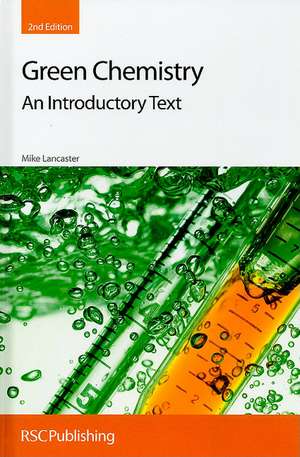Green Chemistry
Autor Mike Lancasteren Limba Engleză Hardback – 30 apr 2010
Sustainable development and environmental issues are at the forefront of public and Government concern. Chemistry and Chemical Engineering may offer the solution to many of these challenges, but chemicals can also be part of the problem. Green chemistry aims to provide environmentally benign products from sustainable resources, using processes that do not harm people or the environment. Aimed at undergraduate and postgraduate students, this introduction to green chemistry encourages new ways of thinking about how products and processes are developed. These include methods of waste minimization, use of renewable feed stocks and the role of catalysis in reducing raw material use. The text is easy to understand and particularly relevant to courses on . It includes case studies and real examples from industry to demonstrate how the techniques work in practice.
| Toate formatele și edițiile | Preț | Express |
|---|---|---|
| Hardback (2) | 283.67 lei 3-5 săpt. | +31.38 lei 6-12 zile |
| Royal Society Of Chemistry – 4 aug 2016 | 283.67 lei 3-5 săpt. | +31.38 lei 6-12 zile |
| RSC Publishing – 30 apr 2010 | 296.58 lei 6-8 săpt. |
Preț: 296.58 lei
Nou
Puncte Express: 445
Preț estimativ în valută:
56.75€ • 59.25$ • 46.97£
56.75€ • 59.25$ • 46.97£
Carte tipărită la comandă
Livrare economică 04-18 aprilie
Preluare comenzi: 021 569.72.76
Specificații
ISBN-13: 9781847558732
ISBN-10: 1847558739
Pagini: 328
Ilustrații: 1
Dimensiuni: 155 x 236 x 25 mm
Greutate: 0.66 kg
Ediția:Nouă
Editura: RSC Publishing
ISBN-10: 1847558739
Pagini: 328
Ilustrații: 1
Dimensiuni: 155 x 236 x 25 mm
Greutate: 0.66 kg
Ediția:Nouă
Editura: RSC Publishing
Cuprins
Chapter 1: Principles and Concepts of Green Chemistry; Chapter 2: Waste: Production, Problems, and Prevention; Chapter 3: Measuring and Controlling Environmental Performance; Chapter 4: Catalysis and Green Chemistry; Chapter 5: Organic Solvents: Environmentally Benign Solutions; Chapter 6: Renewable Resources; Chapter 7: Emerging Greener Technologies and Alternative Energy Sources; Chapter 8: Designing Greener Processes; Chapter 9: Industrial Case Studies; Chapter 10: The Future’s Green: An Integrated Approach to a Greener Chemical Industry; Subject Index
Notă biografică
Mike Lancaster has more than 20 years experience in the chemical industry, mainly with BP in a variety of R&D and Business Management roles. He established the Green Chemistry Network and a Masters course in Clean Technology at the University of York. He has spent the last 6 years with the Chemical Industries Association and has been heavily involved in developing and promoting the sustainable development agenda.
Textul de pe ultima copertă
Sustainable development and environmental issues are at the forefront of public and Government concern. Chemistry and Chemical Engineering may offer the solution to many of these challenges, but chemicals can also be part of the problem. Green chemistry aims to provide environmentally benign products from sustainable resources, using processes that do not harm people or the environment. Aimed at undergraduate and postgraduate students, this introduction to green chemistry encourages new ways of thinking about how products and processes are developed. These include methods of waste minimization, use of renewable feed stocks and the role of catalysis in reducing raw material use. The text is easy to understand and particularly relevant to courses on Clean Technology and Green Chemistry. It includes case studies and real examples from industry to demonstrate how the techniques work in practice.
Recenzii
Green Primers Green Chemistry. An Introductory TextMike LancasterRSC Publishing, Cambridge, UK, 2010, 340pp (HB) ISBN 9781847558732 Reviewed by Lucy Mitton'... Lancaster was the former manager of the UK's Green Chemistry Network, and his book, Green chemistry: an introductory text, is a genuine introduction to the subject for undergraduate and postgraduate students, based as it is on clean chemical technology modules taught at the University of York. Much of the book should be understood by a general readership.Starting from the 12 principles of green chemistry expounded by Paul Anastas in 1998, Lancaster, in a series of well written chapters, discusses such topics as waste minimisation, catalysis, solvents, environmental performance, renewable resources and alternative energy sources.Lancaster's book is not just about green chemistry in the laboratory, but has several chapters on the industrial scene - developing greener technologies and processes as illust
Descriere
Aimed at students, this introduction to green chemistry encourages new ways of thinking about how products and processes are developed.













